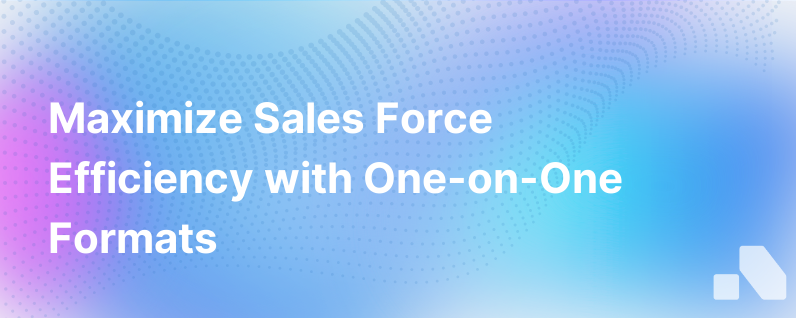
Sales teams are the beating heart of any organization aimed at driving revenue and growth. It's crucial for sales leaders to keep the pulse on their team's morale, motivation, and effectiveness. One effective way to achieve this is through one-on-one meetings. However, not all one-on-ones are created equal, and the format you choose can significantly impact their effectiveness. In this article, we will explore various one-on-one meeting formats that can bolster your sales force effectiveness.
The Importance of One-on-One Meetings
One-on-one meetings between sales managers and their team members are pivotal in fostering a culture of continuous feedback, personal development, and alignment with organizational goals. These meetings offer a private platform for open dialogue, where concerns can be addressed, successes celebrated, and strategies sharpened.
For sales professionals, it's an opportunity to feel heard and supported, while for managers, it's a chance to mentor and guide, unlocking the full potential of each individual. Here are some formats that can enrich the quality of these interactions.
The Goal-Setting One-on-One
Objective: Align individual goals with team and company objectives.
Structure: Begin by reviewing the salesperson's performance metrics and setting short-term and long-term goals. Discuss specific, measurable, achievable, relevant, and time-bound (SMART) objectives, and establish clear action plans to achieve them. This format should be revisited quarterly to ensure alignment and progress.
Outcome: Motivated sales force with clear direction and assertive actions to meet targets.
The Coaching One-on-One
Objective: Enhance skills, address performance issues, and increase overall competency.
Structure: Focus on a key area of improvement or growth that the salesperson wants to develop. Use this time to provide hands-on coaching, share best practices, role-play customer scenarios, or review past sales calls with constructive feedback. These sessions might be scheduled monthly or bi-monthly, depending on individual needs.
Outcome: Enhanced sales skills and a more effective sales approach.
The Strategy Discussion One-on-One
Objective: Refine sales strategies and tactics for specific accounts or opportunities.
Structure: This format revolves around deep diving into strategic accounts. By examining the sales pipeline, you can jointly strategize on approaching prospects, managing accounts, and upselling or cross-selling. Utilize role-plays to practice negotiation techniques or to refine sales pitches based on the client's profile.
Outcome: A tactical approach tailored to each account, leading to more closed deals.
The Career Development One-on-One
Objective: Career progression and professional aspirations management.
Structure: Focus on the salesperson's long-term career goals within the organization. Discuss potential career paths, requisite skills and experiences, and personal development plans. This conversation should take place at least twice a year to keep career goals on track.
Outcome: A motivated salesperson with a clear vision for their future, contributing to job satisfaction and retention.
The Problem-Solving One-on-One
Objective: Identify, discuss, and find solutions to specific obstacles that hinder sales performance.
Structure: This format is more ad-hoc, triggered by a specific issue or setback. It allows for a collaborative approach to problem-solving, where the salesperson presents the challenge, and both manager and salesperson work together on actionable solutions.
Outcome: Quick resolution of challenges and an empowered salesperson who feels supported by their leadership.
The Innovation One-on-One
Objective: Encourage innovative thinking and crowdsource ideas for sales process improvements.
Structure: Create a brainstorming environment where the salesperson can propose new strategies, tools, or processes that could increase efficiency or effectiveness. Foster a creative dialogue about “what could be” at a regular cadence, perhaps every six months.
Outcome: A flow of fresh ideas and a sense of ownership among the sales team.
The Performance Review One-on-One
Objective: Provide formal feedback on performance and discuss appraisals.
Structure: Typically a bi-annual or annual meeting, the performance review should be structured and comprehensive. Review achievements, strengths, areas for improvement, and set specific goals for the next period. This is also a chance to discuss compensation, promotions, or professional development opportunities.
Outcome: A clear understanding of performance, recognition of achievements, and motivation for further growth.
Best Practices for Effective One-on-Ones
Regardless of the format, effective one-on-ones share common best practices, including:
- Preparation: Both parties should come to the meeting prepared with updates, concerns, and topics to discuss.
- Consistency: Regularly scheduled one-on-ones ensure issues don't fester and provide a steady rhythm of feedback and support.
- Active Listening: Sales managers should actively listen, showing genuine interest and empathy in the conversation.
- Actionable Outcomes: Each one-on-one should result in specific actions or follow-up items to keep progress on track.
- Documentation: Keeping a record of discussions, decisions, and action items helps maintain continuity and accountability.
Conclusion
The effectiveness of your sales force can be directly correlated to the amount of time and effort you invest in one-on-one meetings. Through different formats of one-on-one discussions, sales leaders can address various aspects of their team's development and performance. Crafted thoughtfully, these meetings can significantly boost sales force effectiveness, leading to a more engaged, motivated, and successful team.
For sales leaders seeking to transform their engagement strategies, Aomni presents an AI-driven platform that can assist in streamlining account research and providing up-to-date insights, ensuring that every one-on-one is as impactful as possible.